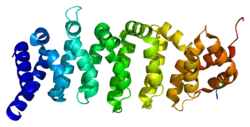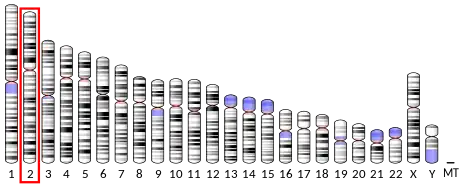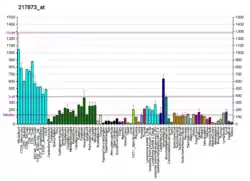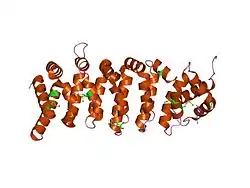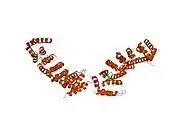CAB39
Calcium-binding protein 39 is a protein that in humans is encoded by the CAB39 gene.[5]
The protein encoded by this gene associates with STK11 (Serine/Threonine Kinase 11) and STRAD (STE20-Related ADaptor protein).[6] CAB39 enhances formation of STK11/STRAD complexes and stimulates STK11 catalytic activity. CAB39 may function as a scaffolding component of the STK11/STRAD complex and regulates STK11 activity and cellular localization.[6]
References
- GRCh38: Ensembl release 89: ENSG00000135932 - Ensembl, May 2017
- GRCm38: Ensembl release 89: ENSMUSG00000036707 - Ensembl, May 2017
- "Human PubMed Reference:". National Center for Biotechnology Information, U.S. National Library of Medicine.
- "Mouse PubMed Reference:". National Center for Biotechnology Information, U.S. National Library of Medicine.
- "Entrez Gene: CAB39 calcium binding protein 39".
- Boudeau J, Baas AF, Deak M, Morrice NA, Kieloch A, Schutkowski M, Prescott AR, Clevers HC, Alessi DR (October 2003). "MO25α/β interact with STRADα/β enhancing their ability to bind, activate and localize LKB1 in the cytoplasm". EMBO J. 22 (19): 5102–14. doi:10.1093/emboj/cdg490. PMC 204473. PMID 14517248.
External links
- Human CAB39 genome location and CAB39 gene details page in the UCSC Genome Browser.
Further reading
- Baas AF, Smit L, Clevers H (2004). "LKB1 tumor suppressor protein: PARtaker in cell polarity". Trends Cell Biol. 14 (6): 312–9. doi:10.1016/j.tcb.2004.04.001. PMID 15183188.
- Hawley SA, Davison M, Woods A, et al. (1996). "Characterization of the AMP-activated protein kinase kinase from rat liver and identification of threonine 172 as the major site at which it phosphorylates AMP-activated protein kinase". J. Biol. Chem. 271 (44): 27879–87. doi:10.1074/jbc.271.44.27879. PMID 8910387.
- Lai CH, Chou CY, Ch'ang LY, et al. (2000). "Identification of novel human genes evolutionarily conserved in Caenorhabditis elegans by comparative proteomics". Genome Res. 10 (5): 703–13. doi:10.1101/gr.10.5.703. PMC 310876. PMID 10810093.
- Strausberg RL, Feingold EA, Grouse LH, et al. (2003). "Generation and initial analysis of more than 15,000 full-length human and mouse cDNA sequences". Proc. Natl. Acad. Sci. U.S.A. 99 (26): 16899–903. Bibcode:2002PNAS...9916899M. doi:10.1073/pnas.242603899. PMC 139241. PMID 12477932.
- Boudeau J, Baas AF, Deak M, et al. (2003). "MO25α/β interact with STRADα/β enhancing their ability to bind, activate and localize LKB1 in the cytoplasm". EMBO J. 22 (19): 5102–14. doi:10.1093/emboj/cdg490. PMC 204473. PMID 14517248.
- Brajenovic M, Joberty G, Küster B, et al. (2004). "Comprehensive proteomic analysis of human Par protein complexes reveals an interconnected protein network". J. Biol. Chem. 279 (13): 12804–11. doi:10.1074/jbc.M312171200. PMID 14676191.
- Milburn CC, Boudeau J, Deak M, et al. (2004). "Crystal structure of MO25α in complex with the C terminus of the pseudo kinase STE20-related adaptor". Nat. Struct. Mol. Biol. 11 (2): 193–200. doi:10.1038/nsmb716. PMID 14730349. S2CID 18401688.
- Lizcano JM, Göransson O, Toth R, et al. (2005). "LKB1 is a master kinase that activates 13 kinases of the AMPK subfamily, including MARK/PAR-1". EMBO J. 23 (4): 833–43. doi:10.1038/sj.emboj.7600110. PMC 381014. PMID 14976552.
- Gerhard DS, Wagner L, Feingold EA, et al. (2004). "The status, quality, and expansion of the NIH full-length cDNA project: the Mammalian Gene Collection (MGC)". Genome Res. 14 (10B): 2121–7. doi:10.1101/gr.2596504. PMC 528928. PMID 15489334.
- Boudeau J, Scott JW, Resta N, et al. (2005). "Analysis of the LKB1-STRAD-MO25 complex". J. Cell Sci. 117 (Pt 26): 6365–75. doi:10.1242/jcs.01571. PMID 15561763.
- Ewing RM, Chu P, Elisma F, et al. (2007). "Large-scale mapping of human protein-protein interactions by mass spectrometry". Mol. Syst. Biol. 3 (1): 89. doi:10.1038/msb4100134. PMC 1847948. PMID 17353931.
This article is issued from Wikipedia. The text is licensed under Creative Commons - Attribution - Sharealike. Additional terms may apply for the media files.
